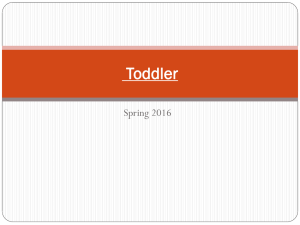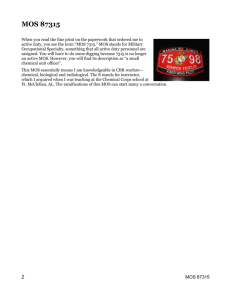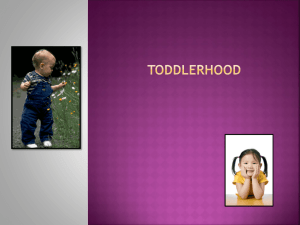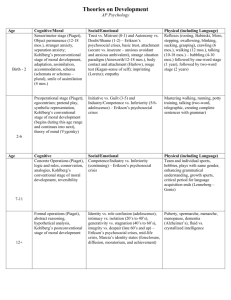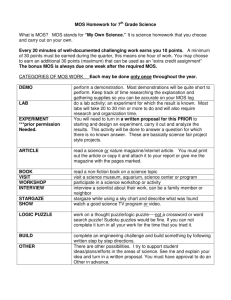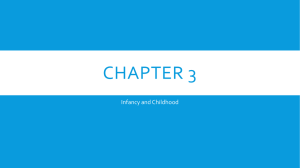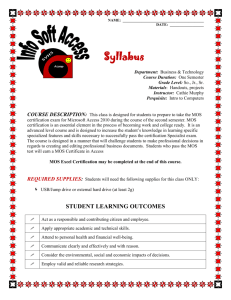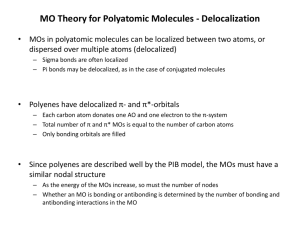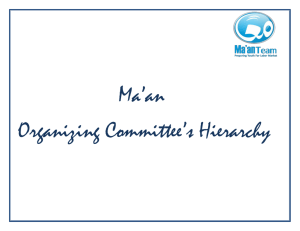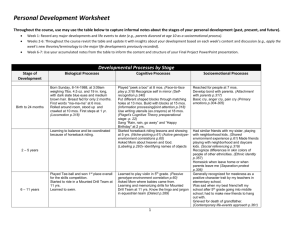Document
advertisement
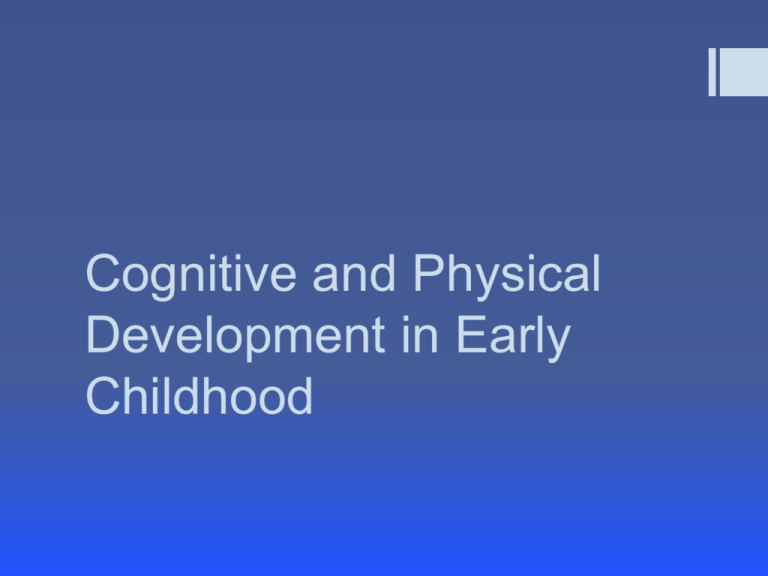
Cognitive and Physical Development in Early Childhood Piaget’s Theory Children adapt to the world by constructing their own cognitive world based on demands in the environment. Processes used to construct: Schema – mental representations of actions or ideas Assimilation – use existing schemas to deal with new information Accommodation – adjusting one’s schema to take in new information or experiences Organization – grouping of behaviors/thoughts into a higher thinking system Examples Car – may include trucks, motorcycles, anything else on road Dog – may include horses, cows, etc. Sensorimotor Stage birth to age 2 coordinates sensory and motor experiences Moves from reflexes only to primitive symbols and complex motor patterns Object Permanence (8-9m) understanding that objects exist even when they cannot be directly seen, heard or touched Acquired when infants search for objects that have disappeared Modifications to Piaget’s theory A-not-B error (3-4m) Reaching for an object where it was located earlier rather than where it was last hidden Language development a form of communication based on a system of symbols that can be written, spoken, or signed. crying cooing (2-4 mos.) – gurgles in the throat, usually show pleasure babbling (6-12 mos) – consonant and vowel combinations, ie ba, ba, ba, ba, ba gestures (8-12 mos) – pointing, bye-bye, nodding higher SES leads to more gestures and a larger vocab at 4.5 years-old From birth to 6 mos, children can recognize diversity in language After 6 mos, they tend to recognize only changes in their “own” language First Words Infants understand speech early A first word doesn’t usually show up until an avg. of 13 mos. Common first words: dada, kitty, car, ball, milk, eye, hat, clock, bye Often these are not clear as day 2 languages Receptive vocabulary – what the child understands (much larger) Spoken vocabulary – words the child uses (smaller) 18 mos. – 50 words 2 years – 200 words called a vocabulary spurt Overextension “dada” – includes dad, other men and boys Underextension “boy” - a neighbor boy, but not a male cousin 18-24 mos. - 2 word utterances “see doggie”, “give book” Telegraphic speech – short, to the point speech without auxillary verbs and other connectives Language environment Child-directed speech – when an adult is talking to a child and takes on a higher pitch than normal Recasting Rephrasing into a question Expanding Restating more elaborately Labeling Naming items Shared reading Reading daily shows direct benefits to a child’s language and cognitive development at 36 mos. Language does have a “critical period” Early childhood Ages 3-5 Physical changes Cognitive development Physical changes Body growth slows from infancy average gains Height 2.5 inches/year Weight 5-7 lbs/year 2 most important variables in growth patterns are: ethnic origin nutrition Physical development of the brain brain undergoes growth in different forms Not size Loss and gain of tissue (pruning) Myelination continues Increase in size and # of dendrites Motor development Increase in speed and dexterity for gross motor skills Continues to improve, and children become interested in more complex tasks Nutrition Strongly influenced by caregiver Predictable schedule Healthy eating Pleasant No distractions (TV, games, etc) Childhood obesity is a problem Exercise is recommended for 2+ hours a day Structured and unstructured Poor nutrition In the US, low income families may qualify for WIC Nutrition education, supplemental foods, and health referrals Illness and death Accidents (all) Cancer Cardiovascular disease Second-hand smoke 22% of US children Asthma Sleep problems Sleep-disorder breathing In other parts of the world the leading causes of death are infectious disease, and problems associated with living in poverty, such as starvation, malnutrition, unsafe water, and lack of safety Piaget’s preoperational stage 2-7 years-old 2nd stage Form stable concepts and begin to reason Dominated by egocentrism and magical beliefs Called preoperational because child cannot yet do operations mentally that they can do physically. Example: 2+4= Egocentrism Children in this stage cannot distinguish between their own perspective and someone else’s. Nodding to people on the phone Animism Believing that inanimate objects have life qualities “The sidewalk tripped me” “My baby is sad” Asking “why” becomes an “delightful” part of their persona Vague ideas What could happen if don’t look both ways How much time do I have to cross? Centration – focusing on only one characteristic at a time Conservation awareness that altering an objects or substances appearance does not change the basic properties of a substance Conservation applies to length, volume, number, matter, and more Vygotsky Social constructivist approach Emphasis on social learning through interaction Includes the zone of proximal development and scaffolding Term for tasks that cannot be completed alone, but child can complete them with assistance Scaffolding – adjusting the amount of support to fit the child’s performance Memory Susceptibility to suggestion by age Individual differences in susceptibility Interviewing can cause distortions Language development Phonology – the sounds of a language including how they are used and combined Morphology – units of meaning involved in word formation By 3 years old most children should be able to pronounce almost all the sounds in their language The morphological rules tend to take longer. Overgeneralization Using plurals, possessives, tense, and prepositions correctly Children do not do this at first. They apply all rules the same “ed” is past tense… So, I goed Literacy Advanced readers How often read to Mother’s education level Amount of books in the home Quality of engagement in home Education Child-centered kindergarten Montessori approach Developmentally appropriate practice Head start Child-centered kindergarten emphasis on process of learning rather than what is learned Each child is unique 1st hand experience is best Play is extremely important Montessori A philosophy in which children are given freedom and spontaneity in choosing activities and are allowed to change activities as desired Developmentally appropriate practice Focus is on typical development of children and the uniqueness of children Head Start Government program to give low income children the opportunity to develop skills needed to be successful in school Early educational experiences are good for individuals and society Controversies Curriculum Universal
